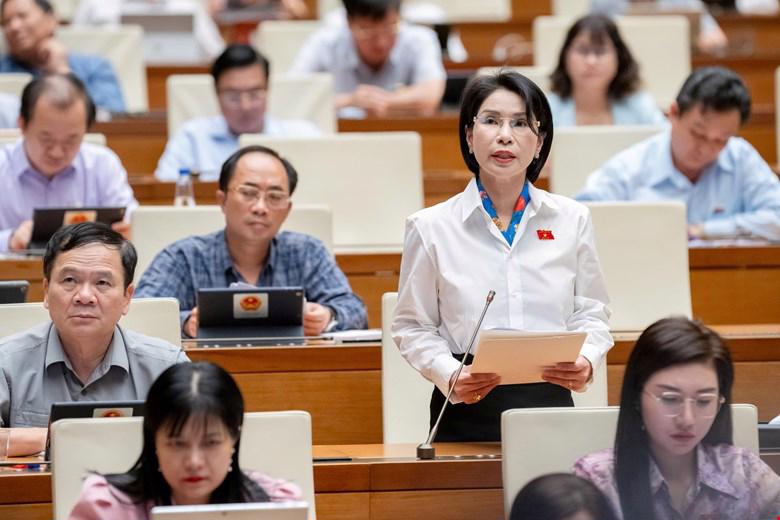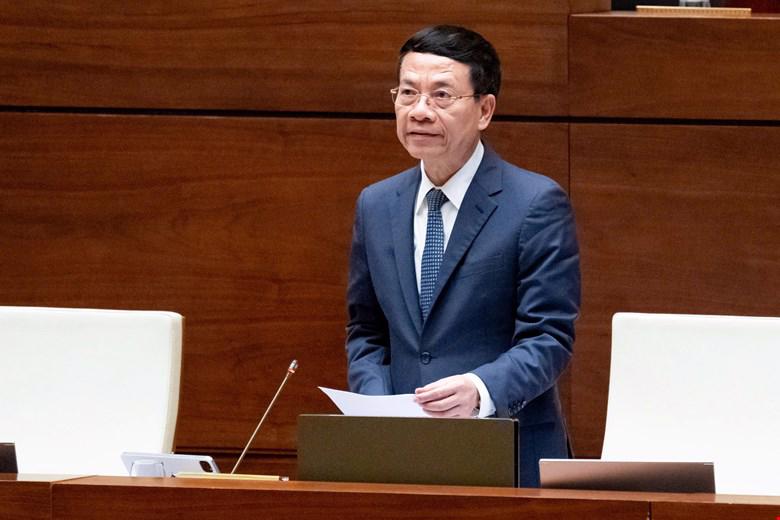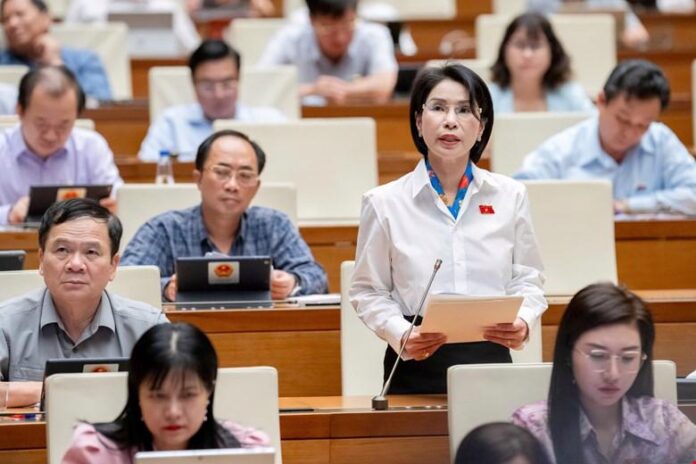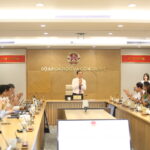Regarding the contribution to the enterprise’s science and technology development fund, Deputy Tran Thi Nhi Ha from Hanoi suggested that the current Government Decree 95/2014/ND-CP stipulates that state-owned enterprises must contribute a minimum of 3% and a maximum of 10% of their taxable income to the science and technology development fund. Meanwhile, non-state-owned enterprises are allowed to contribute up to 10%.
However, a significant step forward was made with the National Assembly’s Resolution No. 193/2025/QH15, which allows enterprises investing in high technology to contribute up to 20% of their taxable income to supplement capital for projects.
Deputy Ha expressed her concern that the current draft law proposes a maximum contribution of only 5%, which contradicts the innovative spirit promoted by the Politburo and the National Assembly.
BARRIERS THAT FREEZE ENTERPRISE’S SCIENCE AND TECHNOLOGY FUND
Referring to Resolution 57 of the Politburo, which emphasizes the importance of having “preferential policies to encourage enterprises, especially small and medium-sized enterprises, to invest in digital transformation, scientific research, technology application, and innovation,” Deputy Ha argued that the current draft’s provisions would demotivate enterprises and limit their resources for long-term investments in technology and creativity. She emphasized that these are crucial factors in enhancing the country’s competitiveness.

According to the deputy from Hanoi, enterprises currently face numerous challenges and obstacles when utilizing their established science and technology funds. These difficulties arise from the Ministry of Finance’s Circular 67/2022, which includes inappropriate regulations regarding budget construction, cost estimates, and management expenses for science and technology tasks.
Many enterprises are confused and worried about spending from the fund because they are unsure about eligible expenses, internal regulations for fund management, and administrative procedures. These issues, she pointed out, are significant barriers that freeze the enterprises’ science and technology funds.
Based on this reality, Deputy Tran Thi Nhi Ha proposed allowing enterprises to contribute up to 15% of their taxable income to the science and technology development fund. For businesses operating in high-tech, digital technology, and strategic technology fields such as chip technology, AI, and big data, she suggested a maximum contribution of 20% to provide a substantial base for investment in research, innovation, and creative endeavors.
The deputy also recommended expanding the fund’s usage to include salaries for development personnel, research and development expenses, hiring experts, purchasing experimental equipment and materials, attending specialized seminars, and acquiring machinery and technology products that directly serve research activities. She further proposed that the Ministry of Science and Technology should issue a detailed list of permissible expenses and remove the mandatory requirement of setting topics or tasks for each expense item. This would provide flexibility for enterprises to utilize the fund according to their actual needs and foster a culture of innovation.
ENCOURAGING ENTERPRISES TO INVEST IN SCIENCE, TECHNOLOGY, AND INNOVATION
Sharing a similar concern, Deputy Sung A Leng from Lao Cai pointed out that while Article 65 of the draft law permits enterprises to contribute up to 5% of their taxable income to their science and technology development fund, this is not entirely aligned with the spirit of Resolution No. 68 of the Central Committee on private economic development.
Resolution 68 allows enterprises to contribute up to 20% of their taxable income to a fund for science, technology, innovation, digital transformation, and research and development. Importantly, it also expands the scope of fund usage, enabling enterprises to conduct internal research and development or outsource it through a product-based contracting mechanism. This flexible approach aligns with the current trend of open innovation.

Therefore, Deputy Sung A Leng suggested that the drafting agency carefully consider adjusting the contribution rate from 5% to a higher level. Increasing the contribution ratio would not only provide enterprises with additional resources for long-term and systematic investments in science, technology, and innovation but also contribute to realizing the goal of developing robust, sustainable, and globally competitive private enterprises.
Regarding financial incentives for investment attraction and human resource development (from Article 51 to Article 54), the draft law has made progress by encouraging enterprises to invest in science, technology, and innovation. However, the deputy from Lao Cai argued that without specific and easily accessible financial mechanisms, these policies would struggle to make a tangible impact, especially for small and medium-sized enterprises, which constitute a significant portion of the economy.
He proposed adding provisions for risk-sharing between the state and enterprises in projects with high applicability and commercialization potential. Additionally, flexible financial instruments such as guarantees, seed capital credit, or preferential interest rates should be considered to encourage enterprises to invest boldly.
Regarding human resource development, the deputy emphasized that it is a core element, but there are still bottlenecks in terms of benefits, working environment, and procedures for attracting domestic and foreign experts. Therefore, the draft should include policies to support enterprises in training their internal personnel, with a mechanism for ordering and bidding for training according to market needs. Special policies are also necessary to attract top talent and industry experts by offering truly attractive working conditions.
On the topic of finance for science, technology, and innovation, the draft law has taken the right approach by addressing the diversification of financial resources and the specificity of this field. However, the deputy suggested that additional specific provisions are needed to ensure feasibility in implementation. He recommended adding regulations for payment upon partial acceptance, suitable for the risky and experimental nature of technology projects. Furthermore, tax incentives for enterprises investing in research and development, venture capital investments, and clearer mechanisms for monitoring and evaluating the efficiency of state financial funds in this field should be clarified.
In response to the issues raised by the deputies, Minister of Science and Technology Nguyen Manh Hung affirmed that science and technology are the foundation of a modern nation. A nation can only be strong if it is strong in science, technology, and innovation. To become a powerhouse, a country must prioritize science, technology, and innovation. Similarly, to achieve developed country status, a nation must foster the development of science, technology, and innovation.

For the first time, the draft law includes a separate chapter on policies to promote research and development and innovation activities within enterprises. According to the minister, “enterprises are empowered and strongly encouraged to invest in research and development, not only with their resources but also with support from the state budget through financial catalyst policies. The principle is that for every dollar invested by the state, we aim to attract $3-$4 from enterprises. In the past, state budget funding for enterprise research and development was less than 10%, but in the future, we aim for 70% to 80%.”
Additionally, the draft law permits enterprises to account for expenses for research and development activities as production and business expenses without any limitations. Previously, there was a cap of around 1% of revenue for research and development expenses, and this was only applicable to profitable enterprises.
The minister further explained that these expenses are eligible for tax deductions with a preferential coefficient of 150% and can even reach 200% if invested in strategic technologies. Moreover, profitable enterprises are allowed to deduct profits before tax to establish a fund for investment in science, technology, and innovation, encouraging large enterprises to support startups, research and development, and the exploration of new technologies and business models.
The Resolution 57 Portal Has “Welcomed” 426 Files of Product and Technology Solutions.
Over ten insightful ideas and initiatives, submitted by scientists, organizations, and individuals via the online portal, have been forwarded by the Ministry of Science and Technology to relevant authorities for further investigation and potential implementation.
Market Beat: Blue-Chip Stocks Keep VN-Index in the Green
The major indices remained in the green territory towards the end of the morning session. By lunch break, the VN-Index posted a gain of 7.62 points, reaching 1,274.92. Meanwhile, the HNX-Index edged slightly lower, settling at 214.42. Market breadth was positive, with 368 advancers outweighing 265 decliners.
The Lucky Winner of the VF3 from GSM: CEO Nguyen Van Thanh Personally Calls with the Good News
The act of giving gifts is a joy, but the journey of distributing rewards can be unexpectedly arduous.
“Vietnam’s High-Speed Revolution: 2,268 km of Expressways and Counting”
“On the morning of May 10, Prime Minister Pham Minh Chinh, head of the National Steering Committee for important projects and key national transport infrastructure projects, chaired the committee’s 17th meeting. As per the meeting’s updates, Vietnam now boasts an impressive 2,268 kilometers of expressway network.”





















